|
|
How can you look inside the sun to see how it shines? In the
mid-1960s, Ray Davis and John Bahcall thought they had a way.
Drawing on advances made by other physicists earlier in the century,
they intended to use notoriously elusive particles called neutrinos
to verify ideas about the sun's inner workings. Theorist Bahcall
calculated the number of neutrinos they expected to find, and
experimentalist Davis tried to catch them. But for more than three
decades, their results didn't jibe. In the chronology below, follow
the case of the missing neutrinos, which ultimately led not only to
a triumph for Davis and Bahcall but also to a surprising
breakthrough in particle physics.—Susan K. Lewis
First Steps
1920: Theory of sunshine
British astrophysicist Sir Arthur Eddington proposes that the sun
generates heat and light by "burning" hydrogen into helium.
According to Eddington, every time four hydrogen atoms fuse to
become a single atom of helium at the sun's core, a tiny bit of mass
is converted into energy, just as Einstein indicated was possible in
his famous equation E = mc2.
1930: Neutrino "invented"
Austrian physicist Wolfgang Pauli conjures up the notion of a novel
subatomic particle to solve a puzzle about the apparent
non-conservation of energy in radioactive beta decays. A few years
later, Italian physicist Enrico Fermi dubs the particle, which has
no electrical charge, the neutrino, or "little neutral one."
But there is no conclusive evidence that the particle exists, and
most scientists think it may be impossible to ever detect.
1939: Theory of sunshine refined
In his landmark paper "Energy Production in Stars," Hans Bethe lays
out details of how hydrogen is fused into helium in stars like the
sun. His work leads to an understanding that the fusion process
releases not only energy but also the particles Pauli "invented."
Each time four hydrogen nuclei change into a helium nucleus, two
neutrinos are emitted.
1956: Neutrino detected
In an endeavor dubbed "Project Poltergeist" conducted at the
Savannah River nuclear reactor, Frederick Reines and Clyde Cowan
prove that the neutrino actually exists.
Grand Experiment
1964: Davis and Bahcall launch test
Ray Davis and John Bahcall propose that a study of neutrinos emitted
from the sun can show that nuclear fusion—the "burning" of
hydrogen nuclei to helium nuclei—is indeed the source of the
sun's energy.
1964: Bahcall predicts number of neutrinos
John Bahcall creates the first detailed mathematical model of fusion
reactions in the sun's interior. As Bahcall later notes, he has to
take account of "a smorgasbord of nuclear reactions at energies
where measurements are difficult." He draws upon Hans Bethe's work,
including Bethe's estimate of the sun's core temperature. There are
countless pitfalls in devising the model. Just a one percent error
in the temperature figure alone means a 30 percent error in the
predicted number of neutrinos. And the projected number is
astounding: about a hundred billion solar neutrinos pass through
your thumbnail every second, according to Bahcall's model.
1965-1966: Davis builds experiment
Deep in the Homestake gold mine in Lead, South Dakota, sheltered
from confusing background radiation, Ray Davis oversees construction
of a giant neutrino trap: a tank of cleaning fluid roughly as big as
an Olympic-size swimming pool. The cleaning fluid is mostly
chlorine, which occasionally turns into a radioactive isotope of
argon when struck by solar neutrinos. Bahcall has calculated that
roughly 10 atoms of argon will be produced each week, and Davis is
confident he can extract and measure them.
1968: Davis's initial results
The much-touted experiment appears a failure. Davis announces that
he has detected only about one third as many radioactive argon atoms
as Bahcall predicted. Scientists call the discrepancy "The Solar
Neutrino Problem." The press calls it "The Mystery of the Missing
Neutrinos."
Decades of Doubt
In the two decades following their disappointing results, Davis
fine-tunes his solar neutrino detector, and Bahcall refines and
checks his calculations. Hundreds of other physicists, chemists, and
astronomers also examine Bahcall and Davis's work. No one can find
significant fault with either the apparatus or the calculations. Yet
along the way there are hints of a solution to the problem:
1969: A possible explanation
Physicists Vladimir Gribov and Bruno Pontecorvo, working in the
Soviet Union, suggest that Davis and Bahcall's missing neutrinos can
be explained by "neutrino oscillations": perhaps, as they travel to
Earth, some of the neutrinos made inside the sun oscillate, or
change, into types of neutrinos that Davis's apparatus can't detect.
It's been known since mid-century that different types of neutrinos
exist. But few physicists take stock in Gribov and Pontecorvo's
idea. According to the Standard Model, the cornerstone of modern
particle physics, neutrino types are distinct and can never change
one into another.
1978 and 1985: Pursuing a bold notion
Building on Gribov and Pontecorvo's radical solution, Lincoln
Wolfenstein in 1978 and Stanislav Mikheyev and Alexei Smirnov in
1985 show how electron neutrinos created at the sun's core might
switch quantum states as they interact with other matter in the sun
and travel outward to the surface.
1985: More missing particles
In an experiment called Kamiokande, sited in the Kamioka Mozumi mine
in Japan, Masatoshi Koshiba and colleagues detect far fewer
atmospheric neutrinos—neutrinos produced by the collision of
cosmic rays with Earth's atmosphere—than they expect to see.
While atmospheric neutrinos are a different type from those produced
by the sun, the so-called "atmospheric neutrino anomaly" is similar
to the solar neutrino problem. Where are the missing neutrinos?
Mystery Solved
1998: Answer to riddle of atmospheric neutrinos
A scaled-up version of Kamiokande called Super-Kamiokande reports on
more than 500 days of data collecting. The detector is so big that
it can tell what direction atmospheric neutrinos are coming from,
and it has picked up far fewer neutrinos traveling from the other
side of the Earth than from the sky directly above Japan. There is
evidence that many of the atmospheric neutrinos from the other side
of the Earth have changed into a different type of neutrino during
their journey. This confirmation of neutrino oscillation carries a
profound implication: the Standard Model of particle physics must be
modified.
2001-2002: Proof of solar neutrino oscillation
The Sudbury Neutrino Observatory (SNO), the first neutrino detector
that can pick up all three known types of neutrinos, resolves
conclusively that, in the case of the missing solar neutrinos, the
neutrinos are not, in fact, missing. SNO finds that the total number
of neutrinos from the sun is remarkably close to what John Bahcall
predicted three decades earlier. Ray Davis's experimental work is
vindicated as well, because SNO finds that only about a third of the
solar neutrinos that reach Earth are still in the same state that
Davis could measure. Roughly two-thirds change type—or
oscillate—during the journey.
2002: Nobel Prize recognizes achievement
The Nobel Prize in Physics is awarded to Ray Davis and Masatoshi
Koshiba, a leader of the Kamiokande group. The Nobel citation
praises them "for pioneering contributions to astrophysics, in
particular for the detection of cosmic neutrinos." The award is also
a tribute to their colleagues and the many dedicated scientists
whose work led to a fundamental shift in particle physics.

|
|
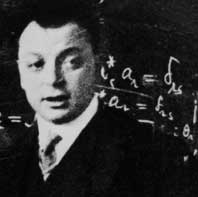
|
Wolfgang Pauli lecturing in 1929. The next year, when he
devised the notion of the neutrino, he allegedly said to
a friend, "I have done something very bad today by
proposing a particle that cannot be detected; it is
something no theorist should ever do."

|
|
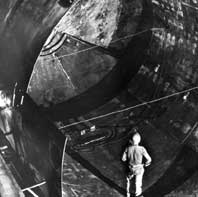
|
When this photo inside the Homestake Mine tank was taken
in 1966, Davis's mammoth neutrino trap was about half
built. From the finished tank, holding 100,000 gallons
of cleaning fluid, Davis hoped to isolate 10 atoms of
argon each week.

|
|
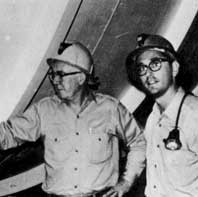
|
More than 4,800 feet underground in the Homestake Mine,
Ray Davis and John Bahcall pose by the tank.

|
|
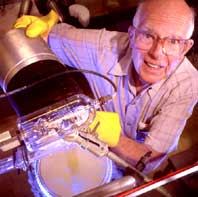
|
Ray Davis continued working on the solar neutrino
experiment until well into his 80s. Here, a 1999
portrait of Dr. Davis at the age of 85.

|
|
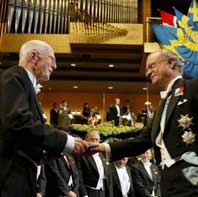
|
Ray Davis's wife Anna, five grown children, and 11
grandchildren were with him in Stockholm as he accepted
the Nobel Prize.

|
|
|

